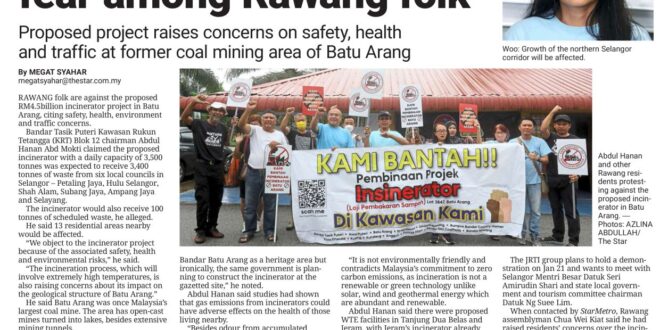THE proposed RM4.5bil waste-to-energy (WTE) incinerator in Batu Arang, Gombak in Selangor, has been drawing much opposition from residents, unlike the one in Jeram, Kuala Selangor, which is being built.
Incinerators create a lot of controversy around the world because of the resulting air pollution and nauseating odours, especially to the immediate surroundings.
According to a World Health Organisation (WHO) report, almost a quarter of cancers globally nowadays are caused by air pollution.
This is the reason why the residents and their supporters are up in arms against the Selangor government’s proposal.
A big-scale rally has been scheduled on Jan 21 in Taman Tasek Puteri.
Unlike the one in Jeram where the air-borne particles could possibly be blown towards the sea, the one proposed in Batu Arang is more problematic as the air-borne pollutants could settle in nearby residential areas and forests. Sungai Selangor flows through this area.
These pollutants will be an additional problem, as much of Selangor depends on Sungai Selangor for water usage.
Malaysia is not so hard-pressed to the extent that it has no alternatives, or is so financially constrained that it has to draw energy from waste and pollute its environment.
The Selangor government is taking the easy way out by not insisting on waste separation at source (households/commercial premises) which can drastically reduce the volume of rubbish sent to the landfills.
The most important point is to reduce to a large extent possible, the rubbish disposed daily in the state that has been priding itself as Malaysia’s first developed state since 2005.
Yet, it still maintains a Third World mentality.
With the rapid rise in the state’s population, including foreign workers, rubbish separation has to be made compulsory or else Selangor will be losing the battle to stop more incinerators from being built.
One only needs to observe the large amounts of garbage disposed by households and business premises to realise the urgent need for a waste-separation scheme in the state.
One sees huge volumes of plastic bottles, various glassware, plastics, cardboards and papers as well as packaging materials being thrown away.
Only a small percentage of these is recycled while the rest goes to the landfill where it is to be buried underground.
Local authorities and the executive councillor for local government need to find solutions to this serious problem.
There is a need for Selangor government to draw up long-term recycling plans in coordination with experts and with those in the recycling industry.
The recycling industry can be assisted in various ways by the government, especially in the introduction of innovative technology.
With the southern districts of Selangor almost fully developed, the next springboard for development will be the northern sector of Selangor.
There are also reasonable grounds, as the residents insist, that the incinerator will have a negative impact for the future growth of the state’s northern districts such as Gombak, Hulu Selangor, Tanjung Karang, Kuala Selangor and Sabak Bernam.
The northern corridor has vast potential and should not be ruined by incinerators.
Remember what happened to the much-hyped Lembah Beringin township when the proposal for a new international airport, which was expected to be located in one of the northern districts, failed to materialise when Sepang was chosen instead?
The incinerators will have the same negative effect on future development in the areas where they are built.
If an incinerator has to be built, why not build it close to the large Bukit Tagar landfill?
It will be more sensible to confine the pollution to one spot instead of dispersing the problem onto many areas.
Batu Arang has been designated as a heritage town and has much potential as a tourist destination.
What Batu Arang needs is good planning by Selayang Municipal Council and the state investment, not roads soiled by leachate spills.
Straightening of the Rawang-Bandar Bestari road and sprucing up existing tourist attractions would be beneficial for the colonial town, which has not recovered from the shutdown of its coal mines after World War II.
V. THOMAS
Sungai Buloh
 BeritaKini.biz Berita Viral Terkini di Malaysia
BeritaKini.biz Berita Viral Terkini di Malaysia





